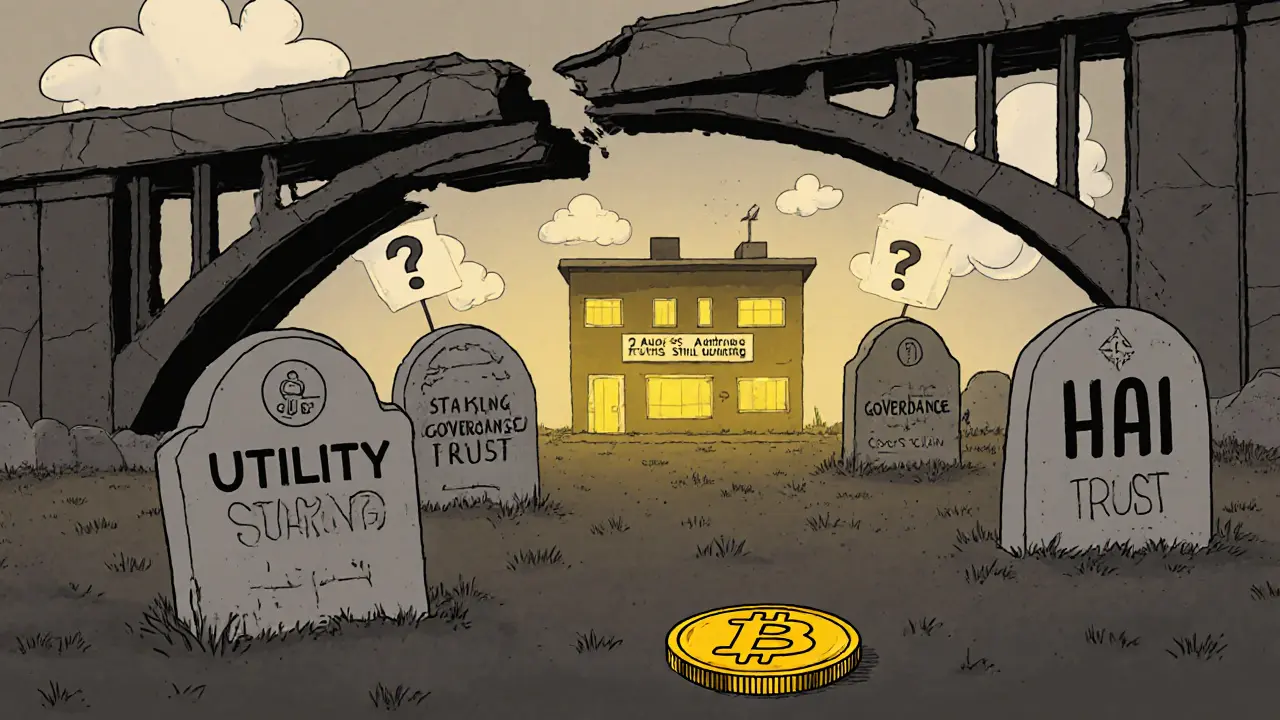There’s no HAI token airdrop. Not now, not soon, and probably never again. If you’ve seen a post, tweet, or Telegram message claiming you can claim free HAI tokens from Hacken, it’s a scam. And here’s why you need to know the truth - before you lose money.
The HAI Token Wasn’t Just Down - It Was Destroyed
HAI, the native token of Hacken, a well-known Web3 cybersecurity firm, didn’t have a slow decline. It got obliterated. In June 2025, a hacker exploited a leaked private key tied to the token’s minting contract. That key allowed them to create new HAI tokens out of thin air - 900 million of them. That’s more than half the total supply.They didn’t just mint tokens. They dumped them. On the Binance Smart Chain, they swapped around $253,000 worth of HAI for BNB before Hacken could react. The result? The token price crashed from $0.015 to $0.000056 in hours - a 99% drop. Today, HAI trades around $0.00026. That’s still down 98% from where it started.
This wasn’t a market correction. It wasn’t a liquidity issue. It was a direct attack on the token’s supply. And it happened to a company whose entire business is securing blockchains.
Why Hacken Was Vulnerable - and How It Happened
Hacken builds security tools for DeFi projects. They audit smart contracts. They monitor on-chain activity. They’re supposed to be the shield. But their own token system had a fatal flaw.The breach happened during an upgrade to their cross-chain bridge - the system that lets HAI move between Ethereum and Binance Smart Chain. The team was trying to make it safer. Instead, they accidentally exposed the private key used to mint new tokens. That key shouldn’t have been accessible at all after launch. But it was. And someone found it.
It’s like a bank hiring top vault designers, then leaving the master key taped under the doormat while they’re renovating the front entrance. Hacken fixed the issue quickly - they revoked the compromised key and shut down the bridge. But the damage was done. The tokens were already in circulation.
No Airdrop. Ever. Here’s the Official Word
Hacken has been clear: there are no HAI token airdrops. Not planned. Not coming. Not even a whisper of one.After the breach, scammers immediately jumped in. Fake websites popped up. Telegram bots started sending messages: “Claim your free HAI airdrop!” They looked real. They used Hacken’s logo. They had fake countdown timers. They even had fake wallet addresses that looked like official ones.
But here’s the truth: Hacken doesn’t do airdrops for HAI. Never has. Never will. Their token was built for utility - staking, governance through hDAO, and access to security tools - not for mass distribution. The only way you get HAI is by buying it on an exchange. And even then, you’re buying a token that lost 98% of its value.
If someone tells you otherwise, they’re trying to steal your crypto. Clicking a link or connecting your wallet to one of these fake airdrop sites can drain your entire balance. No refunds. No recovery.

What HAI Was Supposed to Do - Before the Crash
Before the breach, HAI had real use cases. You could stake it to earn rewards. You could use it to vote on Hacken’s governance system, hDAO. You could get discounts on cybersecurity audits or access to their Trust Army program - a community-driven network for reporting suspicious blockchain activity.It wasn’t a meme coin. It wasn’t a pump-and-dump scheme. It was a functional token tied to a working business. Hacken audited over 1,500 smart contracts by 2025, including projects like Polkadot, Chainlink, and Aave. They had real clients. Real revenue. Real credibility.
But none of that mattered when the token contract was compromised. The utility didn’t vanish - but the trust did. And without trust, the token’s value evaporated.
What Happens Now? Bridge Still Down, No Recovery Plan
The cross-chain bridge between Ethereum and BSC is still offline. No timeline for restoration. No public roadmap. Hacken hasn’t announced any token burn, buyback, or new token issuance plan. They’ve only confirmed they revoked the minter key and stopped all bridge activity.That means if you still hold HAI, you can’t move it between chains. You can’t stake it. You can’t use it in any of its original functions. The token is essentially frozen in place - alive, but useless.
Some exchanges still list HAI. But trading volume is near zero. The price bounces around pennies. It’s not a market. It’s a graveyard.

How to Spot a Fake HAI Airdrop
Scammers are still active. Here’s how to tell if something’s real:- Real Hacken channels: Only official website (hacken.io) and verified Twitter/X account (@hacken_io) are legitimate. Everything else is fake.
- No wallet connection: Legitimate airdrops don’t ask you to connect your wallet to claim tokens. If it requires MetaMask or Trust Wallet access, it’s a trap.
- No urgency: “Claim in 5 minutes!” or “Limited spots!” are classic scam triggers.
- No free money: If it sounds too good to be true - especially after a 99% crash - it is.
Even if you’re holding HAI, don’t try to “recover” it by clicking on recovery tools or token swap services. Those are also scams.
What You Should Do If You Own HAI
If you still have HAI tokens:- Do not interact with any airdrop site, bridge tool, or recovery service.
- Do not send any ETH, BNB, or other crypto to “unlock” your tokens.
- Keep your wallet secure. No one from Hacken will ever ask for your seed phrase.
- Accept that the token’s value is likely gone. There’s no recovery plan in sight.
There’s no silver lining here. Hacken lost trust. HAI lost value. And the airdrop you were hoping for? It was never real.
Final Warning: Don’t Fall for the Next One
This isn’t the first time a security project got hacked. And it won’t be the last. But this case is especially chilling because Hacken is supposed to be the protector - not the victim.It’s a lesson: Even the most trusted names in crypto can be broken by one misconfigured key. And scammers will always be waiting - ready to turn your fear, hope, or curiosity into profit.
So next time you hear about a “big airdrop” from a project that just crashed - pause. Check the official site. Look for announcements. Ask yourself: Why would they give away free tokens after destroying their own value?
The answer? They wouldn’t.
Is there a real HAI token airdrop happening right now?
No, there is no real HAI token airdrop. Hacken has publicly stated that no airdrops are planned or being distributed. Any website, social media post, or Telegram bot offering free HAI tokens is a scam designed to steal your crypto.
Why did the HAI token crash so hard?
The HAI token crashed because a hacker leaked a private key that allowed them to mint 900 million new tokens - more than half the total supply. They dumped these tokens on the market, causing the price to plummet from $0.015 to under $0.0001. The attack exploited a vulnerability during a bridge upgrade, not a flaw in Hacken’s main platform.
Can I still stake or use HAI tokens?
No. The cross-chain bridge is offline, and staking functions are suspended. Hacken has not restored any token utilities since the breach. Even if you hold HAI, you cannot use it for governance, discounts, or any of its original purposes.
Is Hacken still operating after the breach?
Yes. Hacken’s core cybersecurity services - including smart contract audits and on-chain monitoring - were not affected by the token breach. The company continues to operate and serve clients. But the HAI token’s infrastructure is currently inactive, and trust in the token has been severely damaged.
Should I buy HAI tokens now that the price is low?
Buying HAI now is extremely high risk. The token has lost 98% of its value, utilities are frozen, and there’s no clear path to recovery. There’s no official buyback, burn, or upgrade plan. It’s not an investment - it’s speculation on a broken system with no roadmap.

sky 168
November 21, 2025 AT 04:28Just don’t click anything. That’s it. No airdrop. No magic fix. Just don’t engage.
Dexter Guarujá
November 22, 2025 AT 02:36Typical crypto mess. Americans think they can just mint their way to wealth. Hacken was a joke anyway-relying on a single private key? That’s not negligence, that’s incompetence wrapped in a Web3 hoodie. We don’t do this in real finance. Ever.